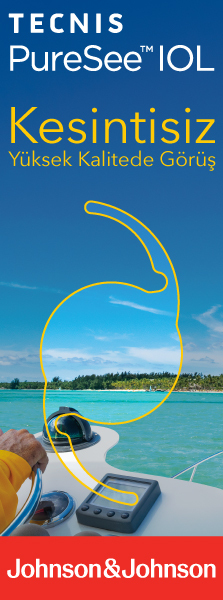TJ-CEO
2008 , Vol 3 , Num 3
The Results of Anterior Capsule Polishing on Anterior and Posterior Capsule Opacification
1Eskişehir Osmangazi Üni. Tıp Fak. Göz Hast. A.D., Eskişehir, Doç. Dr.2Eskişehir Osmangazi Üni. Tıp Fak. Göz Hast. A.D., Eskişehir, Yrd. Doç. Dr.
3Eskişehir Osmangazi Üni. Tıp Fak. Göz Hast. A.D. Başkanı, Eskişehir, Prof. Dr. Purpose: To evaluate the effect of polishing and nonpolishing of the anterior lens capsule on anterior capsule opacification (ACO) and posterior capsule opacification (PCO) during uneventful cataract extraction with phacoemulsification and posterior chamber intraocular lens (IOL) implantation.
Materials and Methods: This prospective randomized doublemasked study included 104 eyes of 104 consecutive patients with age-related cataract. All surgery was performed using a standardized protocol. In Group 1 (n 57), the anterior capsule was extensively polished using an aspiration cannula after phacoemulsification and cortex aspiration. In Group 2 (n:47), the anterior capsule was not polished after phacoemulsification and cortex aspiration. Postoperative ACO and PCO findings were evaluated with biomicroscopic examination in first month every week and then every month to 24th month after surgery.
Results: One hundred-four patients (104 eyes) concluded the study. ACO were seen 9 polished eyes and 17 nonpolished eyes. Two-year the mean ACO score was significantly lower in the eyes in which the anterior capsule had been polished (p<0.01). PCO were seen 14 polished eyes and 21 nonpolished eyes. PCO after polishing did lower significantly (p<0.01). Twelve polished eyes required Nd:YAG laser capsulotomy compared with 21 nonpolished eyes. The mean difference in regeneratory PCO (6 eyes) and fibrotic PCO (8 eyes) with polished eyes, regeneratory PCO (11 eyes) and fibrotic PCO (10 eyes) with nonpolished eyes between the two groups was not statistically significant.
Conclusions: It was found that cleaning up of lens remnants beneath the anterior capsule was effective to prevent anterior and PCO. However, no effect to the type of PCO was seen. ACO might cause difficulties during peripheral retinal examination and certain treatment interventions. Although deliberate cleaning up of the remnants beneath the anterior capsule may prolong surgical time, in our opinion this should reduce the development rate of anterior and PCO. Key Words: Phacoemulsifications, capsule opacification, capsule polishing Keywords : Phacoemulsifications, capsule opacification, capsule polishing





